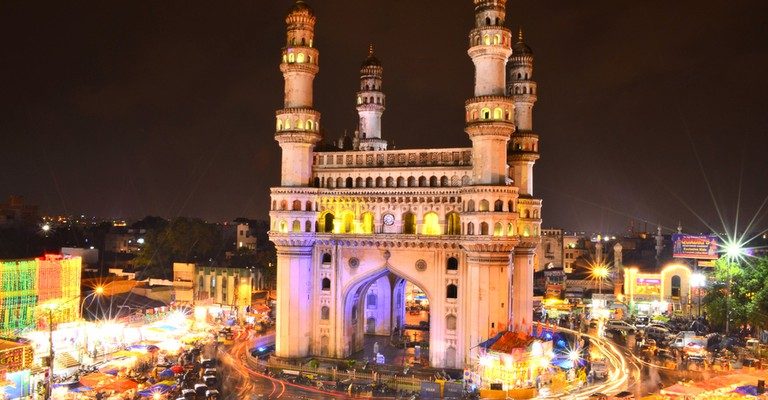Hyderabad: Uttar Pradesh chief minister and BJP leader Yogi Adityanath created ripples in Hyderabad last week when he called upon people to change the city’s name to Bhagyanagar.
“People often ask me if Hyderabad can be renamed Bhagyanagar. I tell them why not,” he said during the BJP’s campaign for the Greater Hyderabad Municipal Corporation (GHMC) polls, voting for which took place on December 1.
While there has been a perpetual debate about the city’s name – on whether it was first called Bagnagar or Bhagnagar and later renamed – many are not aware that this particular aspect is linked to a legend or a love story between Hyderabad’s founder Mohammed Quli Qutb Shah and a Hindu woman named Bhagmati. That it became a part of the BJP’s election campaign is also no surprise, albeit with a Hindutva twist.

File photo of Uttar Pradesh chief minister Yogi Adityanath at a BJP election rally in Jaunpur on October 31, 2020. Photo: PTI
The BJP, or rather Yogi Adityanath, has spun a new tale by attributing the name ‘Bhagyanagar’ to the Bhagyalaxmi temple, which is itself an illegal encroachment on the Charminar, a monument that is the very foundation of Hyderabad. Built in 1591 by Quli Qutb Shah, there are several pictures of the monument from the 1940s and after which clearly show there was no temple.
While it is often debated among experts that the city was first called Bhaganagar, the fact of the matter is that the very existence of Bhagmati, supposedly Quli Qutb Shah’s courtesan/lover, itself is doubted. Although there are historical references of her, no concrete evidence is available to date to prove her as a real figure. Her existence is still a matter of contention.
Also read: Why the BJP Is Campaigning Aggressively in Hyderabad’s Local Body Elections
The irony of all of this is that the Bhagyalaxmi temple that is attached to the Charminar is in fact an illegal structure, which came up between or after the 1960s. Even the Archaeological Survey of India (ASI) acknowledges this. During a presentation at Hyderabad’s Lamakaan forum last year, the former superintending archaeologist of ASI, Milan Kumar Chauley, reiterated the same, and has done it more than once.
The Bhagmati legend
According to legend, Quli Qutb Shah, the fifth of the Golconda kings (who founded Hyderabad), was in love with a Hindu woman named Bhagmati even before Hyderabad was founded. It is said that his father, Ibrahim Qutb Shah, had constructed the Puranapul bridge, which connects the Golconda fort and Old City area in Hyderabad even today, for his son so he could go meet his lover.
The story does not end there. Quli Qutb Shah, it is said, pursued his love, married Bhagmati, and later named the new city he founded (after vacating the Golconda fort, which was a walled city) after her: Bhagnagar. The legend also adds that the city’s name was changed to Hyderabad after Bhagmati converted to Islam and took on the name of Hyder Mahal.

The Golconda Fort in Hyderabad. Photo: Wikimedia Commons.
This is where the problem begins. The late Haroon Khan Sherwani, who is considered to be one of the best historians on the Deccan region, had always refuted the existence of Bhagmati in his works.
In the book History of the Medieval Deccan, edited by him and P. M. Joshi, he points out in the page 459 of the book that “numismatic evidence also points to the same direction (non-existence)…we have coins struck in 1012/1603 at Daru’s-Saltanat Haidarabad, but we have no coin which was minted at ‘Bhagnagar’”.
Sherwani has suggested that the word ‘Bhagnagar’ is a reference to Hyderabad being a “city of gardens”, pointing out that 17th century travellers, like the Frenchman Jean Baptiste Tavernier, used both words Hyderabad and Bhagnagar.
However, another Nizam-era historian, Syed Ali Asgar Bilgrami, negates that and simply says that the city was renamed Hyderabad seven years after her death. “Bhagnagar or the city of Hyderabad was founded by Sultan Muhammad Quli Qutub Shah V, in 999 A. H. (1590 A.D.). Sultan Muhammad Quli’s sweetheart Bhagmati resided in the Chichlam village which is now called Shah Ali Banda and the city of Bhagnagar was styled after name, but after her demise it was denominated Hyderabad…,” reads the opening para from Landmarks of the Deccan on the Charminar.
So, what does all this mean? First, let us be clear about one thing: the Qutb Shahi kings had absolutely no issues with local Telugu people. Quli Qutb Shah’s father, Ibrahim Qutb Shah, was in fact married to Bhaghirati, his mother and a Telugu woman from the Vijayanagar empire. His grandson (and seventh king) Abdullah Qutb Shah was also in love with Taramati, a courtesan, who is buried in the Qutb Shahi Tombs, the necropolis where the Golconda kings are buried.
The name ‘Hyderabad’, however, is mostly a derivative of Hyder, the second name of Imam Ali (son-in-law of the Prophet Mohammed), who Shia Muslims follow. The Qutb Shahis of the Golconda kingdom were orthodox Shias.
Also read: Hyderabad: Prospect of Pulling Down Osmania General Hospital Has Heritage Activists Up in Arms
While old material from historians like Sherwani and Bilgrami have always been around, the city was enthused with a fresh perspective recently through Hyderabad-based journalist Serish Nanisetti’s latest work Golconda/Bagnagar/Hyderabad. His work, which was published after nearly a decade of reportage and research, throws light on the 17th century Portuguese maps also called the city Bagnagar.
“It is undeniable that Hyderabad was known as Bagnagar. Tavernier refers to her (Bhagmati) as a woman, and that the city was built for a woman. Mohd. Quli’s mother is a Hindu woman, so it would not be out of place. Having said that, Hyderabad is a now a brand, and cities keep evolving. Some names survive and some don’t. I don’t think anyone can think of changing it,” says Nanisetti, who is the City Editor for The Hindu in Hyderabad, and extensively covers history and heritage.
What many others also point out is the fact that Bhagmati’s grave has never been found, unlike that of Taramati’s. The latter also has a ‘Baradari’ (garden pavilion) named after her in Hyderabad.
Qutb Shahis and the Deccan’s confluence with Shia Islam
The Qutb Shahi kings, whose founder Sultan Quli hailed from Hamadan (now in Iran), were orthodox Shia Muslims and they always ensured religious harmony in their kingdom, which today comprises primarily of the states of Telangana and Andhra Pradesh. Shia Muslims are essentially followers of Imam Ali, who was the cousin and son-in-law of the Prophet Mohammed. Ali is also considered to be the rightful heir of the Prophet by the Shia sect.
One of his sons, Hussain, was killed in a battle (680) with the Islamic caliphate. The death took place on Ashura, the 10th day of Moharram (first month of the Islamic calendar). It is Hussain’s death that Shia Muslims mourn every year during Moharram. The mourning takes place in Ashurkhanas, which house battle standards or relics known as Alams from the battle of Karabala where Hussain was killed.
The importance of Moharram is immense in Hyderabad and Telangana, given that the Qutb Shahi dynasty built Ashurkhanas across their empire. They appointed local Hindus as caretakers at several of these mourning spaces, due to which even Hindus observe Moharram every year. It is a tradition that continues even today, because of which Hindus in parts of Telangana and Andhra Pradesh observe Peerulu Pandaga (festival of the saints), a local name for Moharram.
It may be noted that the Qutb Shahis also have no link to the Nizams (Asaf Jahi dynasty), who became Mughal-appointed governors of the Deccan, or the erstwhile princely state of Hyderabad, from 1724 up to 1948. The Qutb Shahi or the Golconda period ended in 1687 when Aurangzeb attacked and took over the kingdom in 1687 (also the last Deccan state to fall to the Mughals).
Yunus Y. Lasania is a Hyderabad-based journalist.




